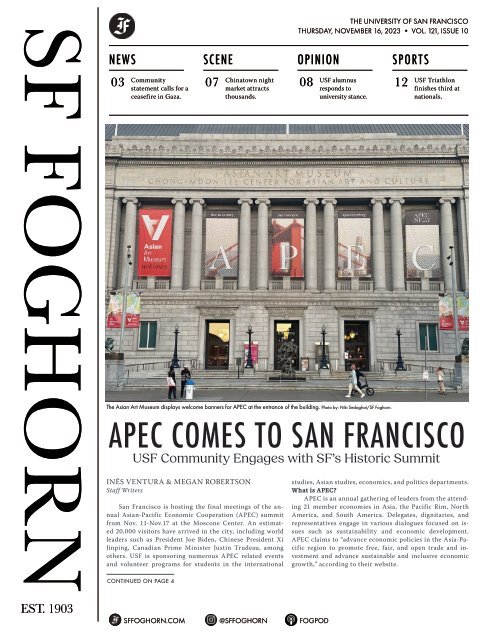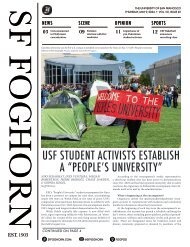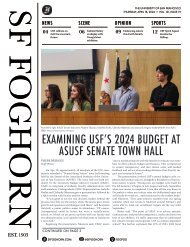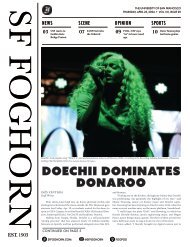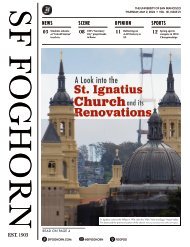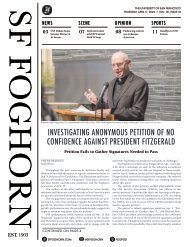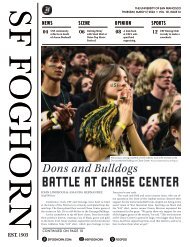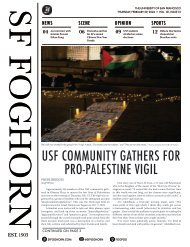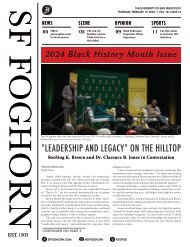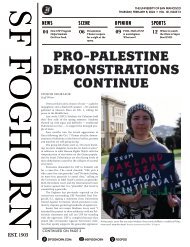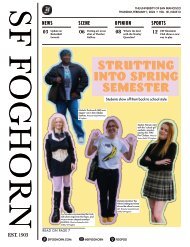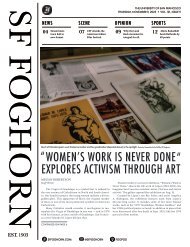Create successful ePaper yourself
Turn your PDF publications into a flip-book with our unique Google optimized e-Paper software.
SF <strong>FOGHORN</strong><br />
NEWS<br />
03<br />
Community<br />
statement calls for a<br />
ceasefire in Gaza.<br />
SCENE<br />
07<br />
Chinatown night<br />
market attracts<br />
thousands.<br />
THE UNIVERSITY OF SAN FRANCISCO<br />
THURSDAY, NOVEMBER 16, 2023 • VOL. 121, <strong>ISSUE</strong> <strong>10</strong><br />
OPINION<br />
08<br />
USF alumnus<br />
responds to<br />
university stance.<br />
The Asian Art Museum displays welcome banners for APEC at the entrance of the building. Photo by: Niki Sedaghat/SF Foghorn.<br />
SPORTS<br />
12<br />
USF Triathlon<br />
finishes third at<br />
nationals.<br />
APEC COMES TO SAN FRANCISCO<br />
USF Community Engages with SF’s Historic Summit<br />
INÉS VENTURA & MEGAN ROBERTSON<br />
Staff Writers<br />
San Francisco is hosting the final meetings of the annual<br />
Asian-Pacific Economic Cooperation (APEC) summit<br />
from Nov. 11-Nov.17 at the Moscone Center. An estimated<br />
20,000 visitors have arrived in the city, including world<br />
leaders such as President Joe Biden, Chinese President Xi<br />
Jinping, Canadian Prime Minister Justin Trudeau, among<br />
others. USF is sponsoring numerous APEC related events<br />
and volunteer programs for students in the international<br />
CONTINUED ON PAGE 4<br />
studies, Asian studies, economics, and politics departments.<br />
What is APEC?<br />
APEC is an annual gathering of leaders from the attending<br />
21 member economies in Asia, the Pacific Rim, North<br />
America, and South America. Delegates, dignitaries, and<br />
representatives engage in various dialogues focused on issues<br />
such as sustainability and economic development.<br />
APEC claims to “advance economic policies in the Asia-Pacific<br />
region to promote free, fair, and open trade and investment<br />
and advance sustainable and inclusive economic<br />
growth,” according to their website.<br />
EST. 1903<br />
SF<strong>FOGHORN</strong>.COM<br />
@SF<strong>FOGHORN</strong><br />
FOGPOD
02 03<br />
THURSDAY<br />
NOV. 16<br />
2023<br />
STAFF<br />
Editor in Chief<br />
MEGAN ROBERTSON<br />
mrrobertson2@dons.usfca.edu<br />
News Editor<br />
NIKI SEDAGHAT<br />
nisedaghat@dons.usfca.edu<br />
Opinion Editor<br />
CHISOM OKORAFOR<br />
cokorafor@dons.usfca.edu<br />
Scene Editor<br />
JORDAN PREMMER<br />
jepremmer@dons.usfca.edu<br />
Sports Editor<br />
CHASE DARDEN<br />
cbdarden@dons.usfca.edu<br />
Photography Online Editor Editor<br />
LEILA ESHA TSELNER DUPUGUNTLA<br />
latselner@dons.usfca.edu<br />
ekdupuguntla@dons.usfca.edu<br />
General Reporter<br />
JORDAN TYLER MARALIT<br />
jcmaralit@dons.usfca.edu<br />
General Reporter<br />
JOR 415.422.5444<br />
DAN sffoghorn.com TYLER MARALIT<br />
jcmaralit@dons.usfca.edu<br />
SUBMISSION POLICY<br />
The San Francisco Foghorn is the<br />
official student newspaper of the<br />
University of San Francisco and<br />
is sponsored by the Associated<br />
Students of the University of San<br />
Francisco (ASUSF).<br />
The thoughts and opinions<br />
expressed herein are those of the<br />
individual writers and do not<br />
necessarily reflect those of the<br />
Foghorn staff, the administration,<br />
the faculty, staff or the students of<br />
the University of San Francisco.<br />
Contents of each issue are the sole<br />
responsibilities of the editors.<br />
An All-American<br />
Publication<br />
ad maiorem dei<br />
gloriam<br />
The San Francisco Foghorn is free<br />
of charge.<br />
Advertising matter printed herein<br />
is solely for informational purposes.<br />
Such printing is not to be construed<br />
as written or implied sponsorship<br />
or endorsement of such commercial<br />
enterprises or ventures by the San<br />
Francisco Foghorn.<br />
©MMIV-MMV, San Francisco<br />
Foghorn. All rights reserved. No<br />
material printed herein may be reproduced<br />
without prior permission<br />
of the Editor in Chief.<br />
SAN FRANCISCO<br />
<strong>FOGHORN</strong><br />
Freedom and Fairness<br />
Managing Editor<br />
JORDAN DELFIUGO<br />
jgdelfiugo@dons.usfca.edu<br />
Copy Editor<br />
INÉS VENTURA<br />
ipventura@dons.usfca.edu<br />
Layout Editor<br />
AVA LORD<br />
ajlord@dons.usfca.edu<br />
Layout Editor<br />
ANYA JORDAN<br />
arjordan@dons.usfca.edu<br />
Social Media Manager<br />
MARIA ZAIED<br />
mfzaied@dons.usfca.edu<br />
Photography Editor<br />
SAMANTHA AVILA GRIFFIN<br />
svavilagriffin@dons.usfca.edu<br />
ADVISOR<br />
TERESA MOORE<br />
2130 FULTON STREET, UC #417<br />
SAN FRANCISCO, CA 94117<br />
Columns for the Opinion section<br />
and Letters to the Editor are gladly<br />
accepted from students, faculty, staff<br />
and alumni.<br />
All materials must be signed and<br />
include your printed name, university<br />
status (class standing or title),<br />
address, and telephone number for<br />
verification. Anonymous submissions<br />
are not published.<br />
We reserve the right to edit materials<br />
submitted. All submissions<br />
become the property of the San<br />
Francisco Foghorn.<br />
Staff editorials are written by the<br />
Foghorn editorial staff and represent<br />
a group consensus.<br />
The San Francisco Foghorn Opinion<br />
page is a forum for the free, fair and<br />
civil exchange of ideas. Contributors’<br />
opinions are not meant to<br />
reflect the views of the Foghorn staff<br />
or the University of San Francisco.<br />
Students interested in contributing<br />
to the Foghorn can scan and fill out<br />
the QR code below.<br />
STAFF EDITORIAL<br />
NO-GO ON CRYPTO<br />
College students aren’t exactly<br />
known for the best financial decisions,<br />
but this year may be harder<br />
than most. This is in part because Investopedia<br />
reports in 2023, the cryptocurrency<br />
market has been performing<br />
poorly all year.<br />
Cryptocurrency, or crypto, is “a<br />
digital currency, which is an alternative<br />
form of payment created using<br />
encryption algorithms” as defined<br />
by the State University of New York.<br />
Many people use cryptocurrencies<br />
as an investment to make money —<br />
in fact, in 2020, the New York Post<br />
found that as many as one in five college<br />
students had used their student<br />
loans to invest in cryptocurrency.<br />
As of April of this year, Pew Research<br />
found that 40% of men from<br />
ages 18 to 29 have used cryptocurrency.<br />
Last year’s major crypto exchange<br />
FTX Exchange collapse has led many<br />
to see the dangers of investing in<br />
cryptocurrency. The FTX collapse,<br />
and founder Sam Bankman-Fried’s<br />
arrest, bode poorly for the future of<br />
cryptocurrency.<br />
FTX, founded in 2019, was a<br />
crypto exchange, which as the Corporate<br />
Finance Institute explains, are<br />
platforms that “facilitate the trading<br />
of cryptocurrencies for other assets,<br />
including digital and fiat currencies.”<br />
They function similarly to stock exchanges.<br />
By 2022, FTX had become<br />
the second largest crypto exchange in<br />
the world, worth $32 billion.<br />
With this success, FTX would<br />
go on to spend $1.1 billion dollars on<br />
celebrity endorsements and sponsorships,<br />
according to CNBC, including<br />
spending millions on a sporting arena<br />
in Miami as well as endorsements<br />
from big names like basketball star<br />
Stephen Curry, “Shark Tank” reality<br />
TV mogul Kevin O’Leary, and comedic<br />
actor Larry David.<br />
At the top of the FTX crypto empire<br />
was Sam Bankman-Fried, who<br />
Forbes reports was once one of the<br />
richest people in crypto. Much of the<br />
wealth was thought to be generated<br />
by broker’s fees from FTX and profits<br />
from the related trading firm Alameda<br />
Research. However, his success<br />
was short-lived.<br />
According to Investopedia,<br />
“FTX’s collapse took place over a <strong>10</strong>-<br />
day period” in Nov. 2022. In the simplest<br />
terms, FTX customers discovered,<br />
due to an investigation by crypto<br />
news site CoinDesk, that a majority of<br />
the assets held by Alameda Research<br />
were in FTT tokens. FTT is the cryptocurrency<br />
created by FTX. What’s<br />
worse, Alameda had taken as much as<br />
$<strong>10</strong> billion from FTX customer funds<br />
to repay its own loans, according to<br />
Reuters. This means much of FTX’s<br />
value was illiquid, meaning it could<br />
not be returned if customers asked<br />
for their money back.<br />
On Nov. 6, Forbes writes, rival<br />
crypto exchange Binance sold 23 million<br />
FTT tokens, leading to a drastic<br />
reduction in the value of the token,<br />
and prompting panicked customers<br />
to begin withdrawing their money<br />
from FTX in what’s known as a bank<br />
run. Within the week, FTX filed for<br />
bankruptcy, and days later Bankman-Fried<br />
was arrested.<br />
Early this November, Reuters reported<br />
Bankman-Fried was convicted<br />
of two counts of fraud and five counts<br />
of conspiracy for stealing an estimated<br />
$8 billion from FTX customers.<br />
Under these charges, the former billionaire<br />
could serve up to <strong>10</strong>0 years in<br />
prison, though the New York Times<br />
estimates that twenty to fifty years<br />
is more likely. U.S. Attorney Damian<br />
Williams called the FTX fraud<br />
“one of the biggest financial frauds in<br />
American history.”<br />
The FTX collapse rippled across<br />
the entire crypto market. The New<br />
York Times stated, “The cryptocurrency<br />
industry has long struggled to<br />
convince regulators, investors and<br />
ordinary customers that it is trustworthy.”<br />
This problem of trust is only<br />
exacerbated by the FTX collapse. Not<br />
only did it eliminate a core pillar of<br />
the crypto environment, it also increased<br />
skepticism around crypto,<br />
harming efforts to normalize the use<br />
of cryptocurrencies.<br />
The FTX collapse is a chilling<br />
reminder of the dangers of investing<br />
in unregulated financial assets. It<br />
leaves a stain that will not be easily<br />
forgotten. Hopefully, after the saga,<br />
students will think twice before using<br />
their student loans on such risky<br />
ventures.<br />
800 USF COMMUNITY MEMBERS CALL<br />
FOR CEASE-FIRE IN GAZA<br />
MEGAN ROBERTSON<br />
Staff Writer<br />
As the Israel-Hamas war enters its sixth week, a number of<br />
demonstrations and calls to action have taken place on the Hilltop.<br />
On Nov. 9, USF community members attended an afternoon “Shut<br />
it Down for Palestine” rally and an evening vigil remembering “all<br />
of the martyrs in Palestine.” An “End the Siege on Gaza” student-led<br />
rally is scheduled for Nov. 14.<br />
While students are leading demonstrations, faculty, staff, and<br />
alums have also mobilized around the war. On Nov. <strong>10</strong>, the Foghorn’s<br />
editorial team learned of a faculty-led “USF Community<br />
Member Statement” calling for a cease-fire in Gaza, which, at the<br />
time of print on Nov. 14, has been signed by 808 USF community<br />
members.<br />
The document, which is circulating via a Google Form, states<br />
that all signatories “stand opposed to the genocide in Gaza, and<br />
believe its our moral obligation to ask our USF community to do so<br />
as well.” At the time of publication, 500 students, 119 faculty and<br />
librarians, 127 alums, 53 staff members, and 9 other community<br />
members have signed their name to the cause.<br />
The faculty-led statement was published on Nov. 3 and aims to<br />
acquire 1,000 total signatories. Philosophy professor Saera Khan<br />
spoke to the Foghorn on behalf of the group of faculty who published<br />
the statement. “This statement emerged from students asking<br />
administration and faculty to make a statement about what is<br />
happening in Gaza,” Khan said.<br />
President Father Fitzgerald, S.J. released an Oct. 16 email statement,<br />
acknowledging the humanitarian crisis in Gaza, but not condemning<br />
the violence or speaking to the political factors at play.<br />
On Oct. 26, Fitzgerald, along with <strong>10</strong>0 other university presidents,<br />
signed the “Universities United Against Terrorism” statement,<br />
which says they “stand with Israel,” and denounce “Hamas<br />
and terrorism.”<br />
Fitzgerald received push back from the USF community due to<br />
this signature, and on Nov. <strong>10</strong> sent a community-wide email where<br />
he stated, “I chose to sign in order to add my voice in<br />
solidarity with Israelis and Palestinians.” A further<br />
in-depth, op-ed response to this letter can be found<br />
in “Palestinians Need Action, Not Prayers” on page<br />
8 of this issue.<br />
“This may be understandable,” Khan said, citing<br />
a Nov. 7 reporting from the Chronicle of Higher<br />
Education, which found that colleges and universities<br />
around the country are refraining from showing<br />
support for Israel or Palestine, due the pressures<br />
of protecting free speech while prioritizing<br />
the safety of Israeli and Palestinian students. “At<br />
the same time,” she continued, “it seems especially<br />
important that an institution that centers social<br />
justice would make a statement.<br />
Julia Laverde, a senior critical diversity studies<br />
major, signed the statement in response to<br />
Fitzgerald’s signature on the “Universities United<br />
Against Terorrism” document.“The 800 of us who<br />
have co-signed the community member statement<br />
are saying ‘not in our name,’” they said. “We refuse<br />
to allow our University’s administration to continue<br />
acting in USF’s declared values of ‘changing the<br />
world from here’ and ‘cura personalis’ by supporting<br />
Israel’s ongoing support of genocide to Palestinians,<br />
both in their words and in their silence.”<br />
The community statement not only calls on action from the<br />
University, but further calls on President Biden “to demand and<br />
facilitate an immediate cease-fire” and “refrain from sending any<br />
more weapons to the Israeli government.”<br />
Senior environmental studies major Jade Carter learned of the<br />
statement through Instagram. “I thought that the fact of students,<br />
faculty, and staff uniting to make a joint statement to and for the<br />
University was a pretty profound move,” she said. “Any way that we<br />
can push the call for a cease-fire is imperative.”<br />
The “USF Community Member Statement” argued that the proposed<br />
cease-fire aligns with USF’s core values. It reads: “As community<br />
members of a Jesuit institution of higher learning, committed<br />
to ‘cura personalis,’ care for the whole person, we call upon all to<br />
consider what it means to bear witness to the plight of Palestinian<br />
people in Gaza facing genocidal Israeli state violence.”<br />
Khan called the statement “a grassroots effort in creating a<br />
voice for faculty, students, staff, and alumni who believe that our<br />
mission would compel us to advocate for a cease-fire and stand<br />
against human suffering.”<br />
Senior business analytics major Jocelyn Luciani signed the petition<br />
after seeing a classmate share it on social media. “It’s important<br />
as students, faculty, and alumni representing an institution,<br />
that we collectively stand against the genocide in Gaza,” she said.<br />
Senior performing arts and social justice major Fayola Jean said<br />
that she signed it out of a duty to the martyred Palestinians. “We<br />
learn about the Holocaust all the time and we always talk about<br />
how, ‘Oh, we wish we could have made a difference,’ or how wrong<br />
it was, but it’s like — when this is happening in the world right now,<br />
what do we do? So I’m on top of like signing all those things, protesting,<br />
sharing posts. Revolution is happening!”<br />
The statement ended by stating, “we mourn for the Palestinian<br />
and Israeli civilians killed, we condemn the rising tide of Islamophobia<br />
and antisemitism in the wake of these events, and we continue<br />
to fight with everything we have for the living.”<br />
Editor’s note: Foghorn staff members Jordan DelFiugo, Niki Sedaghat,<br />
Jordan Maralit, Inés Ventura, Samantha Avila Griffin, Kyla<br />
Menconi, and Chisom Okorafor are signatories to the statement.<br />
Students engage in a walkout protest outside of USF School of Law on Oct. 25th, calling for a ceasefire.<br />
Photo by Samantha Avila Griffin/ Sf Foghorn.<br />
NEWS
04 05<br />
APEC COMES TO SAN FRANCISCO<br />
THURSDAY<br />
NOV. 16<br />
2023<br />
CONTINUED FROM FRONT PAGE<br />
The portion of the summit that will take place here is known as<br />
the APEC Economic Leaders’ Week (ALEW), operating under this<br />
year’s theme of “creating a resilient and sustainable future for all,”<br />
according to the APECSF23 site. ALEW is the final stretch of gatherings<br />
that will conclude APEC’s 2023 season. The summit taking<br />
place in San Francisco will complete the list of U.S. cities hosting<br />
APEC this year, like Palm Springs, Honolulu, Detroit, and Seattle.<br />
Alongside CEOs, entrepreneurs, and other economic stakeholders,<br />
senior global leaders are scheduled to discuss “global opportunities<br />
and challenges that are shaping economic, environmental,<br />
and societal trends,” according to the CEO summit’s official<br />
website. The member economies set to attend account for 60% of<br />
the world’s economy. APEC meetings throughout the year have focused<br />
on regional economic issues, including sustainability, digitalization,<br />
women’s economic empowerment, trade facilitation, energy<br />
and food security, and health.<br />
This is the U.S.’s first time hosting APEC since 2011, and the<br />
third time hosting the summit since its formation in 1989. It will<br />
also mark the city’s “largest international gathering since dignitaries<br />
gathered in 1945 to sign the charter creating the United Nations,”<br />
according to AP.<br />
As part of preparation, the San Francisco Special Events Committee<br />
raised $20.1 million in fundraising for hosting APEC.<br />
Mayor London Breed’s office estimates that the summit will<br />
generate more than $53 million in revenue for the local economy.<br />
“This will be significantly financially impactful for the people here<br />
in San Francisco,” Breed said at a press conference on Oct. 24.<br />
USF’s Participation<br />
USF’s Center for Business Studies and Innovation in Asia-Pacific<br />
(CBSI-AP) hosted the APEC Business Advisory Council’s<br />
“Charting A Sustainable Future” talk on Nov. 13 at USF’s downtown<br />
campus and are co-hosting the inaugural “Jimmy Carter Conversation<br />
on US-China Relations” on Nov. 18 in Lone Mountain with the<br />
Carter Center. CBSI-AP is also connecting students through their<br />
Global Student Ambassadors Program (GSAP) to volunteer at APEC<br />
proceedings at the Moscone Center.<br />
Through his volunteering, first-year entrepreneurship and<br />
innovation major Het Patel greets delegates of the member economies,<br />
members of the press, and other attendees as he registers<br />
them for the summit upon their arrival to the Moscone Center.<br />
“It’s not just signing people up, it’s also networking,” he said. “They<br />
don’t just tell me their names, they talk to me and ask me questions<br />
like ‘Why are you here?’, and when I tell them that I am a freshman,<br />
they tell me how good it is that I am already involved and getting<br />
connected,” said Patel. Students who volunteer through the GSAP<br />
program are exposed to experiences and resources that only exist<br />
outside of their classes. “You never know, you might meet your future<br />
employer,” he said.<br />
Inside the proceedings, senior international business major<br />
Mark Anthony Catahan works alongside the press cabinet of APEC,<br />
which includes major media companies like FOX, CNN, AP, and the<br />
China Global Television Network. “It’s been an enriching experience<br />
to meet these delegates and press,” he said.<br />
“I took the opportunity for two things. One: to learn about<br />
APEC and what the member economies talk about. And two: as an<br />
SF native I want to show delegates how beautiful the city is, because<br />
I love the city and I want to show them what this city has and why<br />
we are so excited for this year’s summit,” Catahan said.<br />
USF’s Chinese Student & Scholar Association (CSSA) is likewise<br />
taking a group of approximately 30 students to volunteer at the<br />
APEC proceedings. CSSA’s group of volunteers are Chinese-identifying<br />
students of all majors.<br />
Asian studies senior, Kunhan Ma, is volunteering through<br />
CSSA for three days of the summit, where she will be welcoming<br />
leaders and dignitaries into the Moscone Center. “I think this experience<br />
can be impactful for my education,” Ma said. “It’s also a good<br />
opportunity to see the President and other Presidents.”<br />
Impact on surrounding areas:<br />
Security measures have been rolled out to prepare the area for<br />
its high-profile guests, with the Secret Service installing more than<br />
<strong>10</strong>-foot tall “unscalable walls” around the Moscone Center and<br />
Yerba Buena Gardens. The main security zone stretches between<br />
Market, Fifth, and Harrison streets, which are closed off. Additionally,<br />
areas around conference events and activities will be closed to<br />
vehicle, transit, and bicycle through-traffic. People will be allowed<br />
to enter security zones to access their homes and businesses with<br />
proper ID shown at security checkpoints and marked entrances.<br />
Encampments of unhoused people which are typically seen in<br />
the South of Market (SoMa) and Tenderloin neighborhoods have<br />
been cleared out by SF Public Works, with unhoused people being<br />
displaced as part of the city’s many preparations ahead of the<br />
summit. Public Works spokesperson Rachel Gordon told the San<br />
Francisco Chronicle on Wednesday that the targeted intersections<br />
“have been on the city’s list of known encampments and are described<br />
as areas of concern because they were growing, in some<br />
cases blocking sidewalks and spilling into the curb lane.” Irrespective<br />
of APEC, the city has been trying to resolve encampments at<br />
those locations “over time.”<br />
Reactions from SF Residents:<br />
At the time of printing on Tuesday, a number of protest actions<br />
have and will continue to occur around the city. The NO to APEC<br />
Coalition, a grassroots collective of more than 150 activist organizations,<br />
plans a week of demonstrations — the majority of which can be<br />
found posted around the Hilltop, from the UC to Kalmanovitz Hall.<br />
In an Instagram statement, these activists claim that APEC encourages<br />
member nations to “further their drive for profits, and<br />
their control over our political, economic, and cultural life, as<br />
well as the rapidly deteriorating climate. Their long-time strategy<br />
to concentrate power and wealth, funds police states around the<br />
Asia-Pacific and Latin America region, locks in an unsustainable<br />
fossil fuel economy and silences our voices of resistance.”<br />
Beginning their week of action on Nov. 11, NO to APEC held a<br />
“Peoples’ Counter Summit” at San Francisco State University, with<br />
more than 1,000 attendees.<br />
Thousands attended NO to APEC’s Nov. 12 protest at the Ferry<br />
Building Plaza, including many USF community members.<br />
Miya Stephanoff, Spring 2023 environmental studies graduate,<br />
went to the protest because they find APEC to be “an amalgamation<br />
of everything evil in our world. Capitalism, white supremacy, patriarchy,<br />
militarization…I could go on and on,” they said. “I had to be<br />
there in protest and scream that business cannot continue as usual.<br />
There were many cultural speakers before the march happened and<br />
they spoke to how intersectional APEC’s impact is.”<br />
Notable aspects of the protest for Stephanoff were the large police<br />
presence and a “language justice team” which interpreted the<br />
event into Spanish and Tagalog. “Protests need to be as accessible<br />
and inclusive as possible because that is a fundamental part of social<br />
justice,” they said. “There were over <strong>10</strong>0 organizations present<br />
and they were all calling not only to end the APEC conference but<br />
also for a cease-fire in Gaza and to free Palestine.”<br />
Thousands are expected to attend Wednesday Nov. 15’s “mass<br />
mobilization event” where activists plan to “put their bodies on the<br />
line” to “creatively block” Wednesday’s CEO summit — in which all<br />
dignitaries are set to attend.<br />
In the op-ed piece, “Why I’m Protesting APEC” on page <strong>10</strong> of<br />
this issue, read more about a USF student’s involvement in the NO<br />
to APEC coalition.<br />
Peru will host the next APEC summit in 2024.<br />
A flier posted near the steps of Lone Mountain urges community<br />
members to “say no to APEC.” Photo by: Megan Robertson/SF Foghorn.<br />
NEWS<br />
Activist group NO to APEC hosted a counter summit on Nov. 12. Screenshot from @no2apec on Instagram.<br />
Activist Alan Marling projects a call to action onto Moscone Center, where the summit is taking place. Screenshot from @aemarling on Instagram.<br />
NEWS
06 07<br />
THURSDAY<br />
NOV. 16<br />
2023<br />
COMMUNITY BUILDING AT COASTAL CLEANUP<br />
SCENE<br />
ELINA GRAHAM<br />
Staff Writer<br />
Volunteers in neon vests and plastic gloves could be seen a mile<br />
away as they gathered in front of Ocean Beach Cafe on Nov. 11, ready<br />
for a morning filled with community service. The cafe works with local<br />
organizations Refuse Refuse, Together SF, and the Civic Joy Fund<br />
to host weekly neighborhood trash pickups, all under the umbrella organization<br />
Clean Up The City. These events use grassroots volunteer<br />
efforts to clean up San Francisco.<br />
Refuse Refuse is one of the largest city-wide garbage collection<br />
organizations. Their cleanups have led to the proper disposal of more<br />
than 457,912 gallons of littered trash.<br />
The nonprofit group Together SF aims to raise civic engagement<br />
and education in the city and organizes events including neighborhood<br />
cleanups, food pantries, and meal deliveries.<br />
The Civic Joy Fund was started as a way for community members<br />
to connect by working on shared communal projects. They helped<br />
sponsor Saturday’s event, paying for all the volunteers’ lunches.<br />
The clean up brought together 52 volunteers from diverse backgrounds<br />
and ages. A large number were students, young people, and<br />
families with children. Ocean Beach cleanup captain Bobak Esfandiari<br />
split the group into four sections, each tackling a different part of<br />
the neighborhood. One team took over the beach, a second the surrounding<br />
walkway and parking lot, the third the Balboa Natural Area<br />
parallel to the beach, and the final group focused on La Playa Street,<br />
the bus station, and the Safeway parking lot.<br />
Handheld mechanical trash grabbers, garbage bags, gloves, and<br />
other essential supplies were provided, and after a quick instructional<br />
speech and welcome from the cafe, volunteers had 90 minutes to<br />
gather all the trash they could before Recology, San Francisco’s waste<br />
management system, came to pick up the collection.<br />
Information regarding clean up locations is located at Clean Up The City’s website. Photo courtesy of Bobak Esfandiari.<br />
“I feel like the city sometimes isn’t doing enough to keep it clean,<br />
so we have to work together to make it cleaner,” said first year marketing<br />
major Megan Galle, who was there volunteering.<br />
In recent years, there has been an increase in littering and illegal<br />
waste dumping in San Francisco streets. The city has a customer<br />
service line where citizens can report abandoned waste, and in 2022,<br />
there were over four times the amount of calls than there were a decade<br />
ago. Recology picked up 8.8 million pounds of illegally dumped<br />
garbage last year.<br />
The city has proposed plans to use movable license plate reader<br />
cameras to identify and take action against those who litter. However,<br />
the process has seen delays since its proposal in 2020, due to a change<br />
in vendors, leading citizens to take the matter into their own hands.<br />
Though these cleanups always yielded a steady turnout of 20-30<br />
volunteers, event leaders said they have noted an increase in volunteer<br />
numbers after the pandemic. Regarding participation, Esfandiari said,<br />
“I think people, as they came out of the pandemic and wanted to get<br />
more involved in their communities again, have been looking for easy,<br />
lightweight ways of getting involved and this is a great way, giving<br />
back to the community and keeping the streets clean.”<br />
Esfandiari, who has been involved in this cleanup since May 2021,<br />
said, “There will always be trash on the beach, at the end of the day.<br />
But for me, one of the greatest joys is the idea that we’re not just picking<br />
up trash on a weekend, but that people are making friends and<br />
connecting in ways that I think is really healthy and good for everyone<br />
involved.”<br />
First-time event attendee Destin Stewart, age 18, said, “I feel like it<br />
builds more of a community. You come together with people you don’t<br />
know and together, you clean up the city.”<br />
Information on joining one of these cleanups can be found on the<br />
Clean Up The City website.<br />
The market comes after the success of the Sunset Night Market, which happened in September. Photo by Jordan DelFiugo / SF Foghorn.<br />
JORDAN DELFIUGO<br />
Staff Writer<br />
SAVORING THE NIGHT<br />
Chinatown night market draws thousands<br />
Guided by the glow of red, paper lanterns hanging above Grant<br />
Avenue and the smells of barbeque pork buns and pastries, thousands<br />
gathered between Pine and Sacramento Streets this weekend<br />
for Chinatown’s night market, where 25 different local vendors sold<br />
pre-made dishes. According to the San Francisco Standard, 99% of<br />
the vendors were local Chinatown restaurants.<br />
The two-day market took place on Nov. <strong>10</strong> and 11, from 5-9<br />
p.m. each night ahead of the Asian Pacific Cooperation Summit<br />
kick-off, which occurred at City Hall on Nov. 11.<br />
For those with a sweet tooth, popular options included Metro<br />
Hong Kong Dessert, as well as<br />
AA Bakery and Cafe, which has operated in San Francisco for<br />
the past 32 years. “The reason I came to the market is because I saw<br />
a video of the AA bakery owner making cupcakes,” said Ji Chuan,<br />
a senior business major who attended the market on Saturday. AA<br />
Bakery and Cafe’s tent drew a large crowd as attendees gathered<br />
around bakery owner, Henry Chen, while he frosted petals onto<br />
cupcakes, creating intricate floral designs on his pastries in real<br />
time.<br />
Steven Lee, who owns three businesses in Chinatown, including<br />
Sam Wo Restaurant, which had a booth at the night market,<br />
explained the event’s purpose in combating negative San Francisco<br />
stereotypes, “We’re basically trying to change the myth, we’re trying<br />
to tell people, ‘don’t believe everything you hear.’ Come down<br />
and visit us and see what we’re doing,” Lee told ABC7. Sam Wo<br />
was a popular attraction for those seeking savory dishes, with their<br />
stuffed noodle rolls.<br />
The event featured a performance from LionDanceMe, who<br />
performed a traditional lion dance, in which multiple dancers operated<br />
a dragon costume, mimicking its movements while accompanied<br />
by a drum circle. According to the New York Freemasons<br />
Athletic club, the ritual is thought to “bring luck and drive away<br />
evil spirits on auspicious occasions.”<br />
The event was organized by the non-profit organization, Be-<br />
Chinatown, a coalition of leaders, merchants, and residents in<br />
Chinatown. According to their website, the organization “aims to<br />
strengthen the community and create economic opportunities for<br />
the neighborhood.”<br />
Kidd Huang, a graduate student in the sports management program,<br />
said, “It’s always fun to see free events in the city, and it<br />
was fun to see another night-market after the massive one at Irving<br />
street.”<br />
In a statement to Yahoo News, Malcolm Yeung, executive director<br />
of Chinatown Community Development Center explained<br />
the purpose of the event “People in the community and the city are<br />
looking at APEC as a potential reset for San Francisco, a relaunch<br />
of our image, certainly our reputation.”<br />
Though entry to the market was free, attendees could purchase<br />
tickets for $5 each to redeem at the booths, a system intended to<br />
streamline transactions for vendors, Hannah Hu, from the Chinatown<br />
Volunteer Coalition, told the San Francisco Chronicle. However,<br />
the popularity of the food led to its vendors selling out in the<br />
first few hours of the market, with some vendors selling out of hot<br />
food as early as 7 p.m. on Friday night.<br />
This left Huang disappointed,.“By the time I got there, they<br />
didn’t have any hot food left– which devastated us because this is<br />
the soul of the market!” However, Huang said she was still able to<br />
enjoy boba from Cool Tea Bar’s booth.<br />
While the food ran out, attendees listened to house music playing<br />
from the Asian Firefighter Association’s DJ booth throughout<br />
the night. “The vibes were on point with music, cool performances,<br />
and obviously loads of amazing food,” said Sammi Chee, junior<br />
chemistry major.<br />
“Just soaking in the whole scene of bringing that Asian<br />
night-market feel to SF was a blast,” Chee, who is from Malaysia,<br />
said, “It’s really cool to see people here in SF enjoying something<br />
that’s such a big part of Asia.”<br />
SCENE
08 09<br />
THURSDAY<br />
NOV. 16<br />
2023<br />
OPINION<br />
PALESTINIANS NEED ACTION, NOT PRAYERS<br />
USF administration’s response to the Israel-Hamas war falls short<br />
VINEET MEHMI is a<br />
2023 USF politics alumni.<br />
Since Oct. 31, heavy<br />
bombardment and shells in Gaza<br />
have killed 2,000 students and<br />
<strong>10</strong>0 school teachers, along with<br />
the destruction of more than<br />
200 schools. According to the<br />
Palestinian News & Information<br />
Agency, more than 600,000 students<br />
will, as a consequence, not be able<br />
to “pursue their fundamental right<br />
to education.”<br />
In response to these barbaric and<br />
tragic events, thousands of students<br />
across the country — including<br />
hundreds of USF students holding<br />
their own protests on campus —<br />
have organized demonstrations to<br />
call attention to the blatant human<br />
rights violations against Palestinians, and the increasing death toll in<br />
Gaza. At the time of publication, 808 community members, including<br />
staff, faculty, alumni, and students have signed a statement standing<br />
unequivocally against “the genocide in Gaza.”<br />
One of the main demands of the USF students’ Oct. 25 protest<br />
was for the USF administration to “publically denounce Israel’s<br />
genocide of Palestinian people through an email to the entire campus<br />
community.”<br />
As we sit privileged in the West, it is our duty to demand recourse<br />
for these gruesome atrocities. I am disappointed that this concept of<br />
condemning violent acts seems to be a challenging idea to grasp for<br />
the USF administration unless it pertains to Hamas.<br />
In response to the escalation by Hamas, President Paul Fitzgerald,<br />
S.J., was quick to put out an Oct. 18 email that labeled the events as<br />
Graphic by Madi Reyes /GRAPHICS CENTER<br />
“defying comprehension.” However, Palestinian civilians have been<br />
facing events that have “defied comprehension” long before Oct.<br />
7, and have almost never received this kind of attention from the<br />
University– an indicator of the intellectual dishonesty being shown<br />
by major institutions across the country.<br />
The violence in the region has been ongoing since the Nakba in<br />
1948 when at least 750,000 Palestinians were displaced beyond the<br />
borders of the state. Under Article 129 of the Geneva Conventions,<br />
forced displacement is considered genocide. This violence continues<br />
to this day, as the Palestinians fight for a right to their own homes.<br />
When asked for a statement on why USF has yet to condemn the<br />
actions of the Israeli government, USF spokesperson Kellie Samson<br />
directed the Foghorn toward a second statement put out by Fitzgerald,<br />
sent to the USF community via email on Nov. <strong>10</strong>.<br />
This statement referenced Fitzgerald’s signature to “Universities<br />
United Against Terrorism,” a letter that denounced “Hamas and<br />
terrorism.” In his Nov. <strong>10</strong> email response, Fitzgerald called for<br />
“the release of Israeli hostages” and noted that he “pray[s] for the<br />
Palestinian people and for an immediate end to the violence that is<br />
causing such horrible and inhumane suffering.” Many members of the<br />
USF community took issue with this statement.<br />
This email was one of a series of lackluster responses that do<br />
nothing to alleviate the concerns of Palestinian advocates. It is<br />
morally egregious that Fitzgerald can sign his support for Israel, but<br />
only extend the same courtesy in the form of prayers for Palestinians.<br />
While USF might not have financial stakes in weapons<br />
manufacturers, standing with Israel and being silent on violence<br />
against Palestinians is akin to supporting their methods of warfare;<br />
tactics that include the use of white phosphorus against civilians.<br />
It is not a surprise, then, that USF students who feel strongly about<br />
Palestine chanted “USF, you can’t hide; you’re supporting genocide”<br />
at a rally on Thursday.<br />
Morally, it is simply a matter of<br />
recognizing the atrocities committed<br />
against the Palestinian people. So<br />
far, USF has refused to explicitly<br />
outline these atrocities or assign<br />
responsibility to Israel, which is why<br />
protesters continue to demand action<br />
and why continued protests by USF<br />
students should be welcomed. USF<br />
cannot remain neutral on genocide.<br />
Given that Fitzgerald is willing<br />
to sign a document that states he<br />
“stand[s] together with Israel Against<br />
Hamas,” he along with all the <strong>10</strong>0<br />
other university presidents listed —<br />
can just as easily demonstrate their<br />
commitment to standing with the<br />
people of Palestine. In the same way<br />
they acknowledge the horrors facing<br />
Israelis, they must be willing to put<br />
out a statement that denounces the<br />
atrocities committed against the<br />
Palestinian people.<br />
If, as the “Universities United<br />
Against Terrorism” document states,<br />
Fitzgerald stands against “murdering<br />
innocent civilians including babies<br />
and children,” the USF administration<br />
should start with the thousands of<br />
innocent civilians who have been<br />
killed over the past month at the hands<br />
of Israeli militarization in the region.<br />
ELISE GREEN is a first- year<br />
international business major.<br />
WILL BARABA LEE’S PALESTINE<br />
STANCE PUT HER AHEAD?<br />
After the passing of Senator<br />
Dianne Feinstein this past<br />
September, Reps. Adam Schiff, Katie<br />
Porter, and Barbara Lee are regarded<br />
as the three election frontrunners<br />
for the California State Senate<br />
Seat, with the Berkeley Institute<br />
of Governmental Studies October<br />
polling results showing 17%, 16%,<br />
and 9% support respectively. All<br />
three prospective senators are from<br />
the Democratic party with similar<br />
platforms, and until recently, the<br />
variation in their campaigns was<br />
slight.<br />
At the Oct. 8 National Union<br />
of Healthcare Workers (NUHW)<br />
Senate Candidate Forum, all three<br />
representatives spoke, and they reached a diversion regarding the<br />
action they’re calling for concerning the Israel-Hamas War. Barbara<br />
Lee’s stance established her individualism in the Senate run, and has<br />
created the opportunity to build off of growing social movements to<br />
further her campaign.<br />
Both Schiff and Porter support increasing American aid for Israel,<br />
with some difference in opinion on how best to handle actionable<br />
defense and the broader issue of gloabl terrorism. In<br />
turn, their platforms remain fairly interchangeable,<br />
making Lee’s stance on the Israel-Hamas War<br />
striking in comparison and appealing to a different<br />
social demographic.<br />
Reminiscent of her voting choices in the<br />
aftermath of the 9/11 attacks, in which she cast the<br />
only vote against the 2001 war in Afghanistan, Lee<br />
is calling for a cease-fire in Palestine. During the<br />
NUHW Senate Candidate Forum, she expressed her<br />
empathy for both Israeli and Palestinian victims,<br />
but provided her thoughts on the United States’ role<br />
in the conflict succinctly.<br />
“Our country has a responsibility, I believe, to<br />
call for a cease-fire and to call for the whole world<br />
to come together to try to stop the escalation of<br />
what is taking place in the Middle East.<br />
And peace is possible if we can bring all parties<br />
together to talk,” she said.<br />
Lee’s call for diplomacy within the Middle East<br />
echoes the results of a CBS News survey published<br />
Oct. 19 which asked respondents about their<br />
feelings on U.S. action regarding the Israel-Hamas<br />
war. Results showed 72% of those surveyed believed<br />
the United States should be engaging in diplomacy<br />
within the region. The overwhelming majority were<br />
calling for less militant approaches, and across<br />
California, there has been a wave of support calling<br />
for similar U.S. action.<br />
Throughout the state, there have been<br />
thousands calling for a cease-fire in Gaza. Protests<br />
have taken place in many of the major cities,<br />
including Los Angeles, San Diego, San Francisco.<br />
Oakland, of which Barbara Lee is the Congressional<br />
Representative, has seen people of all ages take<br />
to the antiwar movement as they denounce the<br />
violence unfolding in the Middle East.<br />
These protests reiterate Barbara Lee’s stance<br />
in contrast to her Senate competitors, and the 30%<br />
of undecided voters across California now have a way to distinguish<br />
the Representatives and their policy beliefs. Coverage of the Israel-<br />
Hamas war has encompassed major media publications, and the<br />
protests calling for a cease-fire are growing every week in California.<br />
Thousands feel strongly about the role the United States should<br />
play in this global conflict. Voting for an official who will lobby for<br />
those same policy beliefs would not be unfounded, given that on an<br />
executive level people are beginning to lobby their votes over the<br />
Israel-Hamas war and the United States’ response. Considering her<br />
advocacy for a ceasefire in Gaza, Barbara Lee may begin seeing new<br />
support from California voters.<br />
For the thousands who have protested, and the many cities seeing<br />
calls for a cease-fire and humanitarian aid, the Senate election is an<br />
opportunity to broaden that voice to the U.S. Government. Barbara<br />
Lee was trailing behind her competitors in the October polls, but the<br />
significance of her stance and broad coverage of news relating to the<br />
Israel-Hamas War puts her in a unique position.<br />
By continuing her advocacy for a ceasefire and diplomatic<br />
approach, Lee could earn the support of those across California with<br />
a similar stance, and unlikeSchiff or Porter, that support would not be<br />
divided with a nearly identical campaign. With the primary election<br />
in March rushing closer, Lee’s campaign chances face an uncertain<br />
trajectory. It’s overwhelmingly her support of a ceasefire in Gaza<br />
that’s her campaign’s defining feature, and may become the driving<br />
force behind her voters by the 2024 Senate election this spring.<br />
Graphic by Sophie Reichert / GRAPHICS CENTER<br />
OPINION
<strong>10</strong> 11<br />
THURSDAY<br />
NOV. 16<br />
2023<br />
WHY I’M PROTESTING APEC<br />
DONS WEEKLY ROUNDUP<br />
OPINION<br />
In light of recent events, I have<br />
struggled to pretend that everything<br />
is fine when corporations and<br />
politicians continue to support and<br />
fund a country that commits war<br />
crimes and continues its genocide<br />
of indigenous Palestinians. Many<br />
people have become jaded or come<br />
down with “boycott fatigue,” and<br />
carry on as if nothing is happening,<br />
leading me to feel alienated and<br />
overwhelmed. That’s why I’ve<br />
been mobilizing in protest of the<br />
MADISON AVERY is a high profile, week-long summit<br />
senior fine arts major.<br />
happening here in San Francisco<br />
this week — the Asian-Pacific<br />
Economic Cooperation summit<br />
(APEC).<br />
You may have noticed the advertisements on MUNI bus stops<br />
stating things like “APEC will be epic.” If you look on the Office of<br />
the United States Trade Representative website, you’ll see that the<br />
meeting is set to facilitate “trade and investment, economic growth,<br />
and regional cooperation.” These vague descriptions hide the much<br />
more sinister plan to eliminate labor and environmental protections,<br />
Graphic by Sophie Reichert / GRAPHICS CENTER<br />
tariffs and taxes, according to a political analysis put out by the JMS<br />
Study Movement. The people who will bear the greatest consequence<br />
of these policies and capitalist developments are the communities of<br />
color in the global South. They are especially vulnerable due to the<br />
longstanding effects of resource extraction, colonization, and the lack<br />
of protection against climate disasters. All of this is “justified” under<br />
the guise of “free trade” and “economic wellbeing.”<br />
On the surface, APEC makes a strong statement with their 2023<br />
theme of “creating a resilient and sustainable future for all.” Those who<br />
are pro-APEC argue that this summit will have many achievements,<br />
including shortening the length of time it takes for goods to cross<br />
borders and “[making] it easier for students, businesspeople, and<br />
tourists to travel around the [Asian-Pacific] region.”<br />
The website even goes so far as to claim that the 21 member<br />
economies aim to “create greater prosperity for the people of the<br />
region” — but who gets to prosper? In the Philippines, ever since the<br />
U.S. occupied the country in 1898, large corporations have ownership<br />
over the means of production and the two governments save money<br />
by being lax on trade regulations. This extraction, privatization,<br />
and deregulation is what leads to many Filipinxs’ displacement,<br />
underemployment, and poverty.<br />
The conference will also impose on the daily life of San<br />
Franciscans. From Nov. 11 - 19, commuters will experience significant<br />
disruptions in transportation. The conference will be held in the<br />
South of Market (SoMa) and Nob Hill areas and an<br />
“exclusion zone” will be enforced. MUNI routes will<br />
be altered, off-ramps will be closed, highway lanes<br />
will be closed, as well as roads, pedestrian and bike<br />
paths around the conference. If you look at the SFMTA<br />
website, you can find only vague descriptions of these<br />
changes. This will add time to everyone’s commute.<br />
Additionally, small businesses around the exclusion<br />
zone will be affected, as the public will have restricted<br />
access to storefronts. They have received little to<br />
no support from the city to prepare for the week of<br />
reduced foot traffic.<br />
Not only will San Francisco residents lose time<br />
and freedom of movement, APEC is also a burden on<br />
taxpayer dollars. According to BBN Bloomberg, “San<br />
Francisco has set aside another $<strong>10</strong> million in taxpayer<br />
funds, mostly for extra policing.”<br />
If you’re sick of seeing governments and<br />
corporations around the world destroy lives, land, and<br />
entire communities without repercussions, I urge you<br />
to get involved with me. The NO to APEC Coalition<br />
comprises more than <strong>10</strong>0 grassroots organizations that<br />
are working together to disrupt the summit and shut<br />
down APEC. If you want more information about what<br />
APEC is and its negative effects, I urge you to head<br />
over to the website and peruse the many resources.<br />
Shutting down APEC won’t solve the issues that<br />
capitalism and free trade agreements create. However,<br />
it will send a strong message to its 21 “member<br />
economies” that we see through their self-proclaimed<br />
goals for “balanced, inclusive, sustainable, innovative<br />
and secure growth” and will fight for our and the rest<br />
of the working class’ rights to a peaceful and healthy<br />
environment. It is also a great opportunity for groups<br />
to organize around a common goal, for people to learn<br />
about different organizations they can join, to inspire<br />
more people to get organized, and build momentum<br />
in the streets. This is a moment when more people,<br />
including USF students, can realize their power and<br />
exercise it in order to change history.<br />
Luana Leite blows by Liliana Marques and Da’Miyah Lewis to get to the basket. Photo courtesy of Chris M. Leung/Dons Athletics.<br />
CHASE DARDEN<br />
Staff Writer<br />
A new season of athletics is in full effect on the Hilltop as winter<br />
sports kick off and fall sports take the backseat.<br />
The Dons’ women’s basketball team started their season at 1-1,<br />
after falling to the University of California, Santa Barbara on Nov. 8<br />
at the Thunderdome and following that game with a 22-point victory<br />
over Stanislaus State University on Nov. 9 at War Memorial Gym. In<br />
both games, the Dons were led by the 2022-23 West Coast Conference<br />
(WCC) Sixth Woman of the Year, Jasmine Gayles. Against UC Santa<br />
Barbara, Gayles posted a career-high 30 points, to go along with five<br />
assists and one steal, on 40% shooting from the field (<strong>10</strong> for 25). Gayles<br />
continued her dominance on the Hilltop, as she finished with 21<br />
points with three assists and three rebounds, which helped the Dons<br />
secure their first win of the season. Following Gayles’ scoring displays,<br />
on Nov. 13, the WCC announced Gayles as the Credit Union 1 WCC<br />
Player of the Week. With back-to-back 20-plus point performances,<br />
she leads the Dons in scoring and also leads the conference in scoring<br />
at 25.5 points per game.<br />
In Idaho, the undefeated Dons’ men’s basketball team went to battle<br />
with the Boise State University Broncos on Nov. 12. In their first game<br />
on the road, the Dons aimed to build on their two early wins against<br />
Bethesda University and Saint Francis University. In enemy territory,<br />
the Dons and Broncos went down to the wire. Through the first half,<br />
the lead was close between USF and Boise State, as the Broncos exited<br />
the first half with a 32-24 lead. Both teams exchanged runs, with the<br />
Dons responding to an offensive surge from the Broncos, as USF went<br />
on an 8-0 run to bring them within two points with 15 minutes left in<br />
the game. The teams went blow-for-blow for the remainder of the game,<br />
with the Broncos prevailing 63-58, giving the Dons their first loss of<br />
the season. Mike Shravjamts, Johnathan Mogbo, Ndewdo Newbury,<br />
and Isaiah Hawthorne starred for USF. For the third straight time<br />
this season, four Dons finished in double digits, Sharavjamts led the<br />
team with 13 points, followed by Newbury with 11, and Mogbo and<br />
Hawthorne with <strong>10</strong> apiece. Mogbo finished with a season-high nine<br />
rebounds, while Newbury recorded a career-high three blocks.<br />
The USF men’s soccer team wrapped up their season on Nov. 11<br />
in Portland, as they took on the number 13 NCAA nationally ranked<br />
University of Portland Pilots. The Dons and Pilots had a defensive<br />
battle as both teams tallied a combined six shots in the first half, with<br />
the first two coming from USF’s own Gabriel Bracken Serra and Max<br />
Chretien. None of the shots found the back of the net for either side, as<br />
both teams headed into the second half, scoreless. The Pilots made the<br />
first scratch with a 49th minute goal from midfielder Nick Fernandez.<br />
The Pilots struck again with an 84th minute goal, ultimately sealing<br />
the win. The Dons ended their season with a record of eight wins, four<br />
losses, and five ties. Though neither of the Dons soccer teams made<br />
the postseason, men’s goalkeeper Eric Waltz recorded five saves in the<br />
game, bringing his total to 45 on the year, which ranks fourth overall<br />
in the WCC.<br />
Women’s and men’s basketball teams continue their season as the<br />
women head to Hawaii to take on the University of Hawaii Rainbow<br />
Warriors at 5 p.m. on Nov 17 on ESPN+. On the same day, the men’s<br />
team will head to Phoenix to take on the Grand Canyon University<br />
Antelopes, on CBS Sports at 5 p.m.<br />
Students can attend all home games for free, with the use of their<br />
One Card.<br />
SPORTS
12<br />
THURSDAY<br />
NOV. 16<br />
2023<br />
TRIATHLON FINISHES THIRD NATIONALLY<br />
CHASE DARDEN<br />
Staff Writer<br />
On Nov. 11, for the second time in three years, the USF Triathlon<br />
team graced the podium at the USA Triathlon Collegiate National<br />
Championship. The Dons finished third overall with a total of 933<br />
points, behind Queens University of Charlotte and Arizona State<br />
University. The Dons competed against 13 other schools at their<br />
competition in Tempe, Arizona.<br />
Kira Gupta-Baltazar, the 2021 NCAA Division 1 National<br />
champion, finished in the top <strong>10</strong> individually for the third straight<br />
year, finishing sixth overall. Along with Gupta-Baltzar, USF triathletes<br />
Molly Elliott, Gillian Cridge, Maddie Perkins, and Heidi Henry all<br />
finished, individually, in the top 50.<br />
The Foghorn spoke to members of the Triathlon team on navigating<br />
challenges as student athletes and looking towards their futures.<br />
Gupta-Baltazar, the Ontario, Canada native, has excelled as a<br />
triathlete at USF, and etched her name in the Dons’ history book. But<br />
her journey to the top wasn’t the clearest.<br />
“Sport includes a lot of ups and downs and I’ve definitely seen both<br />
sides in the past couple of years,” she said. “I had my first major injury<br />
early this past year and was forced out of all physical activity for two<br />
months. The months were challenging and rewarding and I came away<br />
with a greater understanding of myself.”<br />
With the help of her coaches and teammates, Gupta-Baltazar said<br />
she has been able to better develop a work-life balance.<br />
“I’ve learned from my teammates and coaches the importance of<br />
putting my mental health first,” she said. “When I started implementing<br />
activities into my routine that put my mental health first, I noticed a<br />
shift in my motivation. Although consistency is every athlete and their<br />
coach’s dream, it isn’t attainable without consistently putting your<br />
mental health first.”<br />
First-year biology major Maite Kuestner finished eighth overall<br />
individually in her first time competing in the national championship.<br />
Within her performance, Kuestner recorded the fastest bike time ever<br />
by a Don, at 34:08, and the third fastest overall at the competition.<br />
“Coming into the semester, although the podium was a dream for<br />
us, some of us, including me, I kind of struggled to see it as a goal at<br />
first,” Kuestner said. “Quite a few of us were coming off of injuries and<br />
this semester definitely wasn’t easy… it truly was an effort achieved by<br />
every single member of the team.”<br />
Coming from Cologne, Germany, Keustner overcame obstacles of<br />
her own.<br />
“This year’s season was different to what I’m used to in many ways:<br />
moving across half the planet to join a new training group in a new<br />
environment,” she said. “I tried to not set myself any high expectations<br />
while also trusting myself and my coaches…we took this whole year<br />
rather to adjust to the changes, get used to my new life while trying to<br />
keep the momentum I had coming in.”<br />
As Keustner is beginning her collegiate journey in athletics,<br />
Gupta-Baltazar is finishing up her senior year on the Hilltop and<br />
looking towards her future.<br />
“For as long as I remember, my dream has been to be a professional<br />
triathlete,” she said. “I would still very much like to follow that path,<br />
which involves a lot of travel and following the sun.” The biology major<br />
looks to study sports medicine, “but first, hopefully you will see me<br />
on the start line of the 2028 Olympics competing for Team Canada,”<br />
Gupta-Baltazar said.<br />
While many of the familiar USF Triathletes are in the tail end<br />
of their college careers, with the additions of first-year triathletes<br />
Abigail Lotz, Kuestner, and Henry, the Dons can look to carry their<br />
momentum to the national stage again in 2024.<br />
SPORTS<br />
Dons Triathlon stands at the podium for the second time in three years. Pictured from left to right: Maite Kustner, Molly Elliot, Gillian Cridge, Noga Gottlieb,<br />
Maddie Perkins, Veronika Divis, Kira Gupta-Baltazar, Heidi Henry, Clodagh Mellet, Abbey Lotz. Photo courtesy of USF Athletics.


